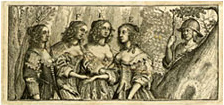Jacob Giles, A New Law-dictionary (1729)
Full Text
Not available
EEBO/TCP
Not available
Date
1729
Lexicographer
Book title
A New Law-Dictionary: Containing, The Interpretation and Definition of Words and Terms used in the Law; And also the Whole Law, and the Practice thereof, Under all the Heads and Titles of the same. Together with such Informations relating thereto, as Explain the History and Antiquity of the Law, and our Manners, Customs, and Original Government. Abstracted from all Dictionaries, Abridgments, Institutes, Reports, Year-Books, Charters, Registers, Chronicles, and Histories, Published to this Time. And fitted for the Use of Barristers, Students, and Practisers of the Law, Members of Parliament, and other Gentlemen, Justices of Peace, Clergymen, &c.
Publication place
London
Printer
E. and R. Nutt, and R. Gosling, (assigns of E. Sayer, Esq.)
Publisher
J. and J. Knapton, J. Darby, A. Bettesworth, F. Fayram, W. Mears, J. Pemberton, J. Osborn and T. Longman, C. Rivington, F. Clay, J. Batley, and A. Ward
Text type
printed book
Genre
Hard-word, term-of-art, and dialect dictionaries, glossaries, and definitions
Subject area
law
Language
headwords: English
explanations: English
explanations: English
explanations: English
explanations: English
Word-group
type: alphabetical
Word-entry
type: headword
sample: Curfeu, (of the Fr. Couvrir, i. e. Tegere, and Feu, Ignis) Signifies the Ringing of a Bell, or Evening Peal, by which William the First, called the Conqueror, commanded every Person to rake up or cover over his Fire, and put out his Light: And in many Places of England at this Day, where a Bell is customarily rung towards Bed-time, it is said to Ring Curfeu. Stow's Annals.
sample: Curfeu, (of the Fr. Couvrir, i. e. Tegere, and Feu, Ignis) Signifies the Ringing of a Bell, or Evening Peal, by which William the First, called the Conqueror, commanded every Person to rake up or cover over his Fire, and put out his Light: And in many Places of England at this Day, where a Bell is customarily rung towards Bed-time, it is said to Ring Curfeu. Stow's Annals.
STC
T137460
Other editions
1732 (ESTC N010098; 2nd edn.)
1733 (ESTC T186773; 2nd edn.)
1736 (ESTC T137461; 3rd edn.)
1739 (ESTC T137462; 4th edn.)
1743 (ESCT N010100; abridged)
1744 (ESTC N010185; 5th edn.)
1750 (ESTC T128794; 6th edn.)
1756 (ESTC T137463; 7th edn.)
1733 (ESTC T186773; 2nd edn.)
1736 (ESTC T137461; 3rd edn.)
1739 (ESTC T137462; 4th edn.)
1743 (ESCT N010100; abridged)
1744 (ESTC N010185; 5th edn.)
1750 (ESTC T128794; 6th edn.)
1756 (ESTC T137463; 7th edn.)
Influences
- Hambridge, Roger A. "Smollett's Legalese: Giles Jacob's New Law Dictionary and Sir Launcelot Greaves." Revue des Langues Vivantes 44 (1978): 37-44. view record




